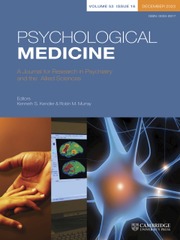Crossref Citations
This article has been cited by the following publications. This list is generated based on data provided by
Crossref.
Vilaplana, Miriam
Mckenney, Kathryn
Riesco, María D.
Autonell, Jaume
and
Cervilla, Jorge A.
2010.
Comorbilidad depresiva en los trastornos de la personalidad.
Revista de Psiquiatría y Salud Mental,
Vol. 3,
Issue. 1,
p.
4.
Mooi, B.
Comijs, H. C.
Cladder, M. A.
and
Beekman, A. T. F.
2010.
Alexithymie bij depressieve ouderen: een relevante persoonlijkheidstrek?.
Tijdschrift voor Gerontologie en Geriatrie,
Vol. 41,
Issue. 3,
p.
126.
Mooi, B.
Comijs, H. C.
Cladder, M. A.
and
Beekman, A. T. F.
2010.
Alexithymie bij depressieve ouderen: een relevante persoonlijkheidstrek?.
Tijdschrift voor Gerontologie en Geriatrie,
Vol. 41,
Issue. 3,
p.
126.
LARSSON, MAGNUS R.
BÄCKSTRÖM, MARTIN
MICHEL, PER-OLOF
and
LUNDH, LARS-GUNNAR
2010.
The stability of alexithymia during work in a high-stress environment: A prospective study of Swedish peacekeepers serving in Kosovo.
Scandinavian Journal of Psychology,
Bamonti, Patricia M.
Heisel, Marnin J.
Topciu, Raluca A.
Franus, Nathan
Talbot, Nancy L.
and
Duberstein, Paul R.
2010.
Association of Alexithymia and Depression Symptom Severity in Adults Aged 50 Years and Older.
The American Journal of Geriatric Psychiatry,
Vol. 18,
Issue. 1,
p.
51.
Vilaplana, Miriam
McKenney, Kathryn
Riesco, María D.
Autonell, Jaume
and
Cervilla, Jorge A.
2010.
Depressive comorbidity in personality disorders.
Revista de Psiquiatría y Salud Mental (English Edition),
Vol. 3,
Issue. 1,
p.
4.
Tolmunen, Tommi
Lehto, Soili M.
Heliste, Maria
Kurl, Sudhir
and
Kauhanen, Jussi
2010.
Alexithymia Is Associated With Increased Cardiovascular Mortality in Middle-Aged Finnish Men.
Psychosomatic Medicine,
Vol. 72,
Issue. 2,
p.
187.
Gritti, Paolo
Lombardi, Salvatore
Nobile, Barbara
Trappoliere, Paola
Gambardella, Antonio
Di Caprio, Ester Livia
and
Resicato, Gianluca
2010.
Alexithymia and Cancer-Related Fatigue: A Controlled Cross-Sectional Study.
Tumori Journal,
Vol. 96,
Issue. 1,
p.
131.
Chen, Po-Fei
Chen, Cheng-Sheng
Chen, Cheng-Chung
and
Lung, For-Wey
2011.
Alexithymia as a Screening Index for Male Conscripts with Adjustment Disorder.
Psychiatric Quarterly,
Vol. 82,
Issue. 2,
p.
139.
Tolmunen, Tommi
Heliste, Maria
Lehto, Soili M.
Hintikka, Jukka
Honkalampi, Kirsi
and
Kauhanen, Jussi
2011.
Stability of alexithymia in the general population: an 11-year follow-up.
Comprehensive Psychiatry,
Vol. 52,
Issue. 5,
p.
536.
Kojima, Masayo
2012.
Alexithymia as a prognostic risk factor for health problems: a brief review of epidemiological studies.
BioPsychoSocial Medicine,
Vol. 6,
Issue. 1,
p.
21.
Kano, Michiko
and
Fukudo, Shin
2013.
The alexithymic brain: the neural pathways linking alexithymia to physical disorders.
BioPsychoSocial Medicine,
Vol. 7,
Issue. 1,
p.
1.
Karukivi, Max
2014.
Development of alexithymic personality features.
World Journal of Psychiatry,
Vol. 4,
Issue. 4,
p.
91.
Alqahtani, Mohammed M.J.
2015.
An investigation of emotional deficit and facial emotion recognition in traumatic brain injury: A neuropsychological study.
Postępy Psychiatrii i Neurologii,
Vol. 24,
Issue. 4,
p.
217.
Li, Shuwen
Zhang, Bin
Guo, Yufang
and
Zhang, Jingping
2015.
The association between alexithymia as assessed by the 20-item Toronto Alexithymia Scale and depression: A meta-analysis.
Psychiatry Research,
Vol. 227,
Issue. 1,
p.
1.
De Panfilis, Chiara
Ossola, Paolo
Tonna, Matteo
Catania, Lorena
and
Marchesi, Carlo
2015.
Finding words for feelings: The relationship between personality disorders and alexithymia.
Personality and Individual Differences,
Vol. 74,
Issue. ,
p.
285.
Marchesi, Carlo
Ossola, Paolo
Scagnelli, Francesca
Mellini, Lorenzo
Tonna, Matteo
Ardissino, Diego
and
De Panfilis, Chiara
2015.
The role of alexithymia in predicting incident depression in patients at first acute coronary syndrome.
Comprehensive Psychiatry,
Vol. 62,
Issue. ,
p.
86.
Bilotta, Elena
Giacomantonio, Mauro
Leone, Luigi
Mancini, Francesco
and
Coriale, Giovanna
2016.
Being alexithymic: Necessity or convenience. Negative emotionality × avoidant coping interactions and alexithymia.
Psychology and Psychotherapy: Theory, Research and Practice,
Vol. 89,
Issue. 3,
p.
261.
Gourounti, Kleanthi
Anagnostopoulos, Fotios
Griva, Faie
and
Vaslamatzis, Grigorios
2016.
Alexithymia and fertility-related stress.
Women & Health,
Vol. 56,
Issue. 3,
p.
312.
Duarte, Joana
and
Pinto-Gouveia, José
2017.
Correlates of psychological inflexibility mediate the relation between alexithymic traits and positive emotions.
Journal of Contextual Behavioral Science,
Vol. 6,
Issue. 1,
p.
96.

